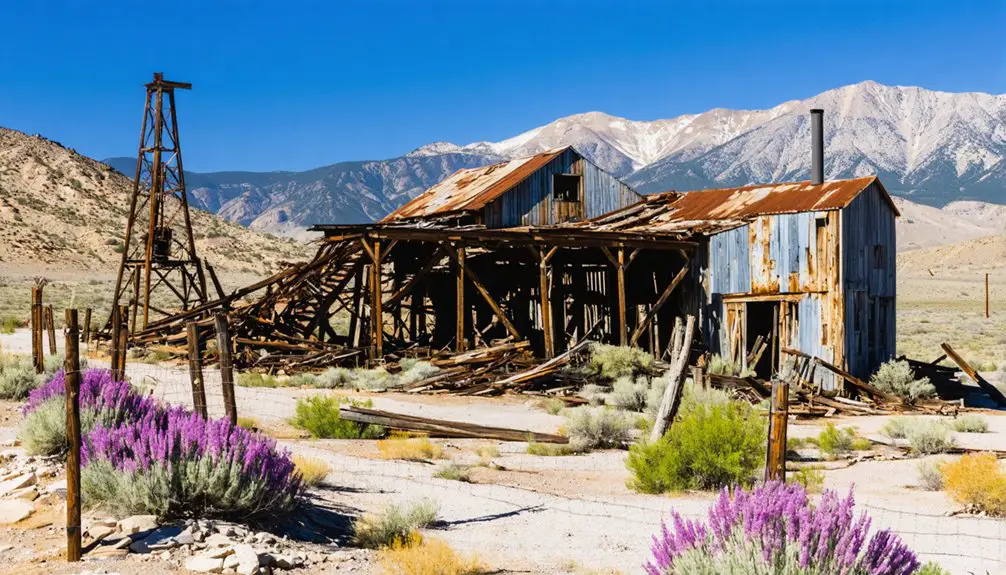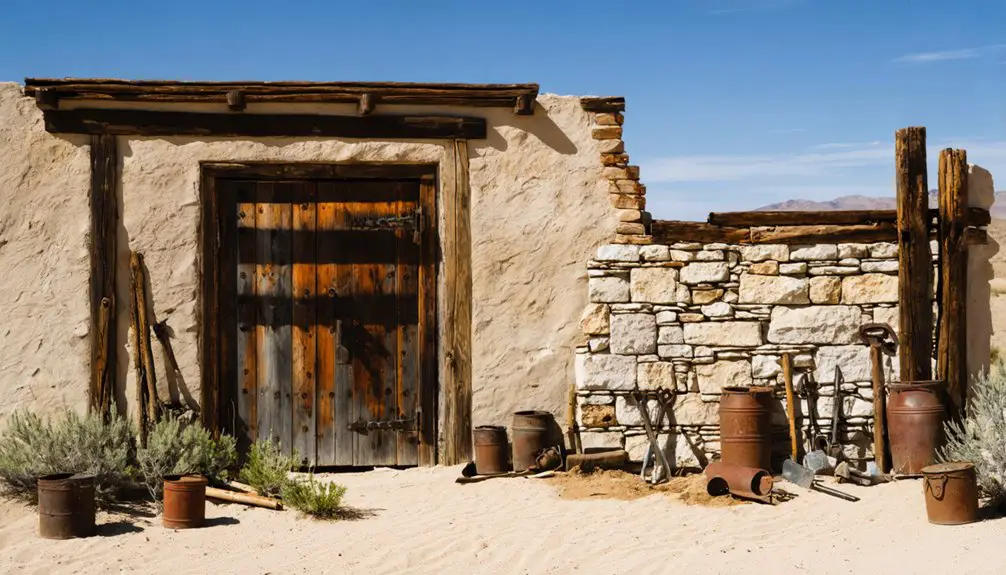You’ll find Parran’s ghostly remnants alongside US 95 in Churchill County, Nevada, where this former Southern Pacific Railroad telegraph station thrived from 1902 to 1912. The site served as a crucial “jerkwater” stop and salt production hub, processing 200 tons annually through the Kinney Salt Works. Today, scattered foundations, rusted equipment, and weathered grave markers tell the story of this desert outpost’s brief but significant role in Nevada’s industrial development. The site’s artifacts reveal deeper layers of frontier innovation and perseverance.
Key Takeaways
- Parran was established in 1902 as a Southern Pacific Railroad telegraph station in Churchill County, Nevada, located 22.8 miles north of Fallon.
- The ghost town operated as a “jerkwater” stop for steam engines and housed the Kinney Salt Works, supporting about 30 residents.
- Salt production peaked at 200 tons annually but ended in 1912 when International Salt Company closed, leading to the town’s decline.
- Archaeological remains include deteriorating wooden fences, metal burial plot markers, scattered building foundations, and various mining equipment.
- The site’s coordinates are 39.8013° N, -118.7732° W at 3,884 feet elevation, with preserved adobe structures and artifacts from early 20th-century operations.
The Birth of a Telegraph Station Town
While the Southern Pacific Railroad sought to improve its Nevada routes in 1902, they planned Parran as a strategic telegraph station along their newly rerouted Carson River line.
You’ll find this station’s origins rooted in the railroad’s push to modernize telegraph technology and streamline railroad logistics after taking control from the struggling Central Pacific in 1899.
The station’s establishment marked a significant shift in regional communications, opening officially on January 29, 1910, to serve a small population of about 30 people.
As a “jerkwater” stop, Parran provided essential water resources for steam engines traversing the arid landscape.
The location was carefully chosen to avoid the challenging terrain of White Plains Hill, making it an important node in Southern Pacific’s expanding network of desert outposts. The common surname Parran was chosen to identify the station, following railroad naming conventions of the era.
Engineers could efficiently gather water without leaving their train cabins using a special water tank system.
Salt Industry’s Brief Reign
Although Parran’s salt industry operated briefly from the early 1900s to 1912, it played a significant role in supplying local farmers with essential mineral resources.
Parran’s short-lived salt works became a vital supplier of minerals to area farmers in the early twentieth century.
The Kinney Saline Deposits Association established the initial salt production facility, which later fell under the management of Desert Crystal Salt Company and International Salt Company. You’ll find that this operation, though modest in scale, became a critical economic lifeline for the region’s agricultural community. Salt production in the region reached 200 tons annually during peak operations.
The town’s origins trace back to its establishment as a telegraph station site in 1902. The salt works’ economic viability faced mounting challenges as railroad routes shifted and regional competition intensified. Despite supporting a community of roughly 30 residents at its peak, the industry’s limited scope ultimately proved unsustainable.
When International Salt Company terminated its lease in 1912, Parran’s brief industrial chapter came to an end, triggering the town’s swift decline into abandonment.
Life at the Kinney Salt Works
Since its establishment in 1902, the Kinney Salt Works operated with a small workforce of local laborers who endured Nevada’s harsh desert conditions to harvest and process salt.
You’d find these hardy workers braving extreme temperatures, from scorching summers to frigid winters, as they extracted salt deposits from evaporation ponds near Parran.
Worker conditions were basic at best, with minimal shelter and provisions available during their shifts. You wouldn’t find many luxuries at the site – just staple foods and rudimentary accommodations. Production could reach ten tons per acre during the intense summer months.
The remote location and transient nature of the workforce meant social life was sparse, without formal community establishments.
Salt harvesting remained largely manual labor, using simple tools and techniques typical of early 20th-century operations until the works’ closure in 1913. The Carson River route provided crucial transportation access for distributing the processed salt.
Communication Hub of Churchill County
When Southern Pacific Railroad established Parran in 1902, they strategically positioned it as an important telegraph station along their newly rerouted Carson line. Telegraph advancements transformed this small outpost into a significant communication hub, where operators transmitted critical train orders and messages to guarantee safe rail operations through Churchill County.
You’ll find that community dynamics revolved around this junction of communication services. The telegraph station, combined with a post office that operated from 1910 to 1913, served roughly 30 residents while supporting the nearby Kinney salt works.
Operating during two key periods (1902-1903 and 1907-1908), Parran’s role in message relay proved essential for Southern Pacific’s restructured Nevada service, especially after natural disasters disrupted infrastructure along the line.
Daily Operations and Postal Services
You’ll find that Parran’s mail processing followed standardized procedures of the early 1910s, with incoming correspondence sorted by destination and outgoing mail categorized by priority for the Southern Pacific Railroad’s postal cars.
The telegraph station‘s dual role as a post office made it the central communications hub for salt works personnel, area farmers, and railway workers needing to coordinate shipments and business matters.
The station’s efficient handling of both postal and telegraph services proved essential for the salt industry’s operations until the post office’s closure in 1913. Like many ghost towns in Nevada, this closure signaled the beginning of Parran’s decline into abandonment.
Mail Processing Methods
During its brief operational period from 1910 to 1913, Parran’s post office integrated telegraph and mail services to support the bustling salt works industry and local agricultural shipments.
The facility’s mail sorting operations were closely tied to the Southern Pacific Railroad‘s schedule, ensuring efficient processing of both incoming and outgoing correspondence.
You’ll find the crucial mail processing methods included:
- Telegraph transmissions for urgent messages, coordinated with traditional postal routes
- Transfer of mail from railroad cars to local wagons for final delivery
- Daily sorting and dispatch of commercial parcels from the International Salt Company and regional farmers
Despite limited staff and infrastructure, you’d have witnessed a sophisticated operation that maintained detailed records while serving as a crucial communications hub for this frontier outpost.
Community Communication Hub
Three essential services converged at Parran’s communication hub between 1910 and 1913: postal operations, telegraph transmissions, and railroad coordination.
This strategic convergence created crucial communication networks that connected isolated Churchill County residents to the wider world.
You’d find the hub bustling with activity as it processed mail, transmitted telegrams, and managed railroad communications.
Similar to the Amargosa Station setup, Parran relied heavily on its railroad infrastructure for maintaining postal services and regional connectivity.
The facility’s historical significance stemmed from its role in linking the Kinney salt works to external markets while serving local farmers and businesses.
The Southern Pacific Railroad‘s presence enhanced the hub’s efficiency, enabling swift transport of both messages and materials.
When you consider Parran’s remote location, this communication center proved indispensable for maintaining commercial and social connections in an era before widespread telephone adoption.
The Decline and Abandonment
Although Parran began with promise as a telegraph station and salt-production hub in 1910, its decline came swiftly after the Kinney salt works ceased operations in 1912.
The town’s economic viability crumbled as the single-industry economy couldn’t sustain community resilience in Churchill County’s harsh environment. This pattern of decline was common, as Nevada has over 600 ghost towns scattered across its landscape. Today, the area reflects resource depletion as the primary cause of its abandonment.
You’ll find three key factors that sealed Parran’s fate:
- The closure of the Kinney salt works eliminated the town’s primary source of employment and revenue
- Declining demand for rail services left the town increasingly isolated
- Lack of reliable water sources made permanent settlement unsustainable
Geographic Features and Location

Nestled in Churchill County’s high desert landscape, Parran stands at coordinates 39.8013° N, -118.7732° W, with an elevation of 3,884 feet above sea level.
You’ll find this ghost town 22.8 miles north of Fallon along US 95, where the arid terrain presents typical elevation challenges of Nevada’s Great Basin region.
The site’s geographic position made it ideal for its historical role as a Southern Pacific Railroad station, with nearby springs and water tanks supporting rail operations through the harsh desert landscape.
The surrounding environment features rocky terrain and sparse vegetation characteristic of the region’s high desert ecosystem.
Today, you can access Parran via the main highway, though you’ll want a suitable vehicle for traversing the less maintained rural roads leading to this former railroad outpost.
Industrial Legacy in Nevada
While Parran’s industrial significance pales in comparison to Nevada’s major mining centers, the ghost town reflects the state’s broader industrial heritage that generated over $322 billion in gold production alone.
You’ll find remnants of mining technologies that shaped Nevada’s development, from early ore processing to transportation infrastructure.
The industrial impacts of Nevada’s mining boom can be seen through:
- Extensive railroad networks that connected mining districts, opening up the state’s interior
- Technological advances in open-pit mining and heap leaching that revolutionized mineral extraction
- Legacy structures like charcoal ovens and processing facilities that stand as evidence to 19th and early 20th-century mining practices
These industrial artifacts tell the story of Nevada’s transformation from isolated territory to mining powerhouse, where companies like Nevada Gold Mines continue to employ thousands and contribute billions to the state’s economy.
Remnants and Archaeological Findings

At Parran’s ghost town site, you’ll find deteriorating wooden fences and occasional metal grates outlining burial plots, alongside scattered building foundations and mining equipment remnants that typify early 20th-century Nevada mining settlements.
You can observe adobe and stone structural remains showing better preservation than wooden elements, with stamp mills and mining tailings dominating the industrial landscape.
The site’s artifacts include rusted metal tools, household ceramics, and glass shards, though preservation efforts face challenges from harsh desert conditions and unauthorized collecting activities.
Physical Site Features Today
The physical remnants of Parran’s brief existence from 1910-1913 reveal a spartan desert settlement centered around telegraph and postal operations.
Today, you’ll find the ghost town features largely reclaimed by Nevada’s harsh desert environment, with most structural remnants reduced to foundations and scattered debris fields.
Key visible elements include:
- Deteriorated building foundations suggesting telegraph station and post office locations
- Surface-level artifact scatters containing period-specific glass, metal, and ceramic fragments
- Possible raised structural elements where recent stabilization work has occurred
The site’s archaeological value lies primarily in its brief but significant role in early 20th-century communication infrastructure, though you’ll need to navigate unmarked gravel roads to explore these weathered remains yourself.
Historical Artifact Preservation Status
Since Parran’s abandonment in 1913, surviving artifacts have revealed a complex material legacy spanning mining equipment, personal effects, and architectural remnants.
You’ll find scattered mining tool fragments and machinery parts that tell the story of its industrial past, though many have deteriorated due to harsh desert conditions and scavenging.
The site’s artifact conservation status remains precarious, with minimal active preservation efforts protecting the remaining physical evidence.
While some historical documentation exists in county records, most artifacts lie exposed to the elements, slowly disappearing into the landscape.
Desert weathering has particularly affected wooden structures and organic materials, leaving primarily metal and stone remnants.
Without dedicated preservation initiatives, these tangible connections to Parran’s mining era continue to fade, making urgent documentation of surviving artifacts critical.
Preserving Parran’s History
Preserving Parran’s rich history requires a coordinated effort between Nevada’s State Historic Preservation Office (SHPO) and numerous stakeholders, including local governments, Native American tribes, and preservation organizations.
Effective historic preservation demands collaboration across government agencies, tribal nations, and community groups to protect our shared cultural heritage.
You’ll find that community involvement is essential in addressing preservation challenges, particularly given the site’s remote location and exposure to harsh desert conditions.
Key preservation activities at Parran include:
- Documentation of remaining telegraph station ruins and salt works foundations through archaeological surveys
- Stabilization of fragile structures using conservation technologies to prevent further deterioration
- Collection of oral histories and archival materials that detail the site’s 1910-1913 operational period
You can participate in preservation efforts through guided tours, volunteer initiatives, and educational programs that help maintain this important piece of Churchill County’s industrial heritage.
Frequently Asked Questions
What Was the Average Population of Parran During Its Operational Years?
Hey fam, you’d find average demographics of about 30 people during its short run from 1910-1913, though population fluctuations occurred as workers came and went supporting the salt works.
Were There Any Schools or Churches Established in Parran?
You won’t find any educational history or religious influence here – no schools or churches were established during the brief operational period, as the town focused solely on industrial needs.
What Happened to the Telegraph Equipment After the Station Closed?
You won’t find definitive records, but the telegraph equipment’s legacy likely followed standard railroad practices: dismantling for reuse elsewhere in Southern Pacific’s network or scrapping during the station’s 1913 closure.
Did Any Families Continue Living in Parran After 1913?
You won’t find evidence of families staying in Parran post-1913. Once the salt works closed in 1912 and the post office shuttered in 1913, the town’s economic foundation crumbled, forcing everyone’s departure.
What Transportation Methods Were Used to Reach Parran’s Remote Location?
You’d reach this desert outpost primarily by railroad access along Southern Pacific’s line, with secondary wagon trails serving local transport needs. After 1902, telegraph stations supported coordinated rail travel.
References
- https://en.wikipedia.org/wiki/Parran
- https://travelnevada.com/ghost-town/the-metropolis-that-wasnt/
- https://www.youtube.com/watch?v=lXyHDThvoLU
- https://en.wikipedia.org/wiki/List_of_ghost_towns_in_Nevada
- https://pinatravels.org/ghost-towns-near-las-vegas/
- https://www.forgottennevada.org/sites/parran.html
- https://www.nevadaghosttownsandmininghistory.com/portfolio-2/parran
- https://www.nvexpeditions.com/churchill/parran.php
- https://en.wikipedia.org/wiki/Timeline_of_North_American_telegraphy
- https://www.nvexpeditions.com/churchill/huxley.php



